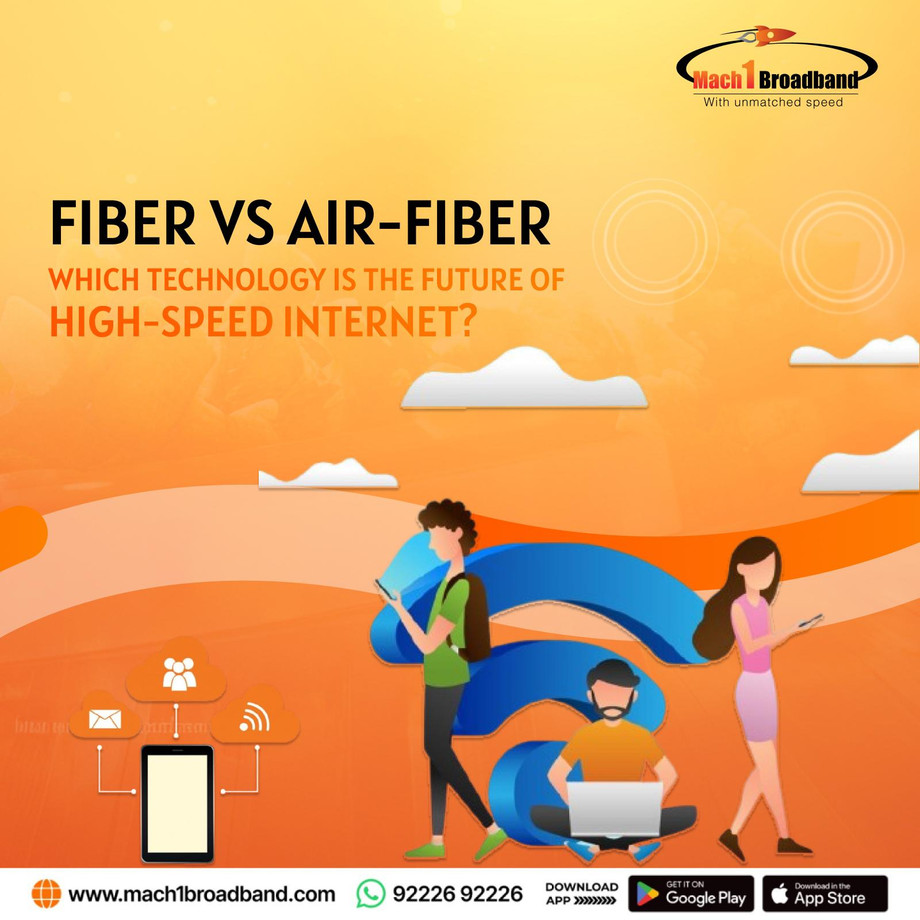The demand for high-speed internet has never been higher. With the proliferation of smart devices, remote work, and online entertainment, reliable internet connectivity has become a cornerstone of modern life. Among the technologies vying to deliver the best experience, fiber-optic internet and AirFiber are two contenders generating buzz. But which of these technologies truly holds the future of high-speed internet? Let's dive deep into their features, advantages, and challenges to find out.
Understanding Fiber and Air-Fiber Technologies
What is Fiber-Optic Internet?
Fiber-optic internet uses thin strands of glass or plastic to transmit data as pulses of light. This technology offers unparalleled speed, reliability, and bandwidth.Fiber-optic cables are placed underground or on poles. They connect directly to homes and businesses. This setup offers equal upload and download speeds.
Key Features of Fiber:
-
Incredible Speed: Fiber can deliver speeds up to 1 Gbps or higher, suitable for heavy data users.
-
Low Latency: Ideal for gaming, video conferencing, and other real-time applications.
-
Scalability: Fiber networks can handle increasing demands for bandwidth with minimal upgrades.
What is Air-Fiber?
Air-Fiber, on the other hand, is a wireless technology that uses radio waves to transmit data. It typically involves point-to-point communication between towers and end-users Air-Fiber is different from fiber. It does not need a lot of cables. This makes it faster and possibly cheaper in some places.
Key Features of AirFiber:
-
Wireless Flexibility: Requires minimal infrastructure, enabling rapid deployment.
-
High-Speed Connectivity: Capable of delivering speeds comparable to fiber in optimal conditions.
-
Adaptability: Suited for remote or hard-to-reach locations.Comparing Fiber and AirFiber
Speed and Performance
Fiber-optic internet is the best choice for speed. It can send data nearly at the speed of light. This helps users browse, stream, and download without any issues. Fiber also provides equal speeds for uploads and downloads. This is very important for businesses and content creators.
AirFiber, while capable of high speeds, is often subject to environmental interference. Weather conditions, physical obstructions, and signal congestion can impact performance. AirFiber technology is getting better, but it is not as reliable as fiber for peak performance yet.
Installation and Accessibility
Fiber installation requires significant groundwork. The process involves laying cables, which can be time-consuming and expensive, particularly in rural or underdeveloped areas. This has led to a slower rollout in certain regions.
AirFiber, on the other hand, shines in its ease of deployment. With minimal infrastructure, AirFiber can be installed quickly, making it an attractive option for rural or underserved communities.However, it needs line-of-sight communication. This can be hard in places with rough ground or thick plants.
Cost Considerations
The upfront cost of installing fiber-optic networks is significantly higher than Air-Fiber However, once installed, fiber networks require minimal maintenance and offer a longer lifespan, making them cost-effective in the long term.
Air-Fiber’s lower initial investment makes it a viable option for internet service providers (ISPs) looking to expand coverage quickly. However, ongoing maintenance and the potential need for frequent upgrades to improve performance may increase costs over time.
Scalability and Future-Proofing
Fiber’s ability to handle massive amounts of data makes it inherently future-proof. As demand for bandwidth continues to grow, fiber networks can scale up with relative ease.
Air fiber, while innovative, faces limitations in scalability. The finite spectrum available for wireless communication and potential interference issues may hinder its ability to meet future demands without significant technological advancements.
Use Cases and Best Applications
Fiber: The Urban Workhorse
Fiber-optic internet excels in urban environments, where high population densities demand robust and reliable connectivity. It’s also ideal for businesses, educational institutions, and healthcare facilities that require consistent high-speed internet for critical operations.
Air-Fiber The Rural Savior
AirFiber is a game-changer for rural and remote areas where laying fiber cables is impractical or cost-prohibitive. Its ability to bridge the digital divide quickly makes it an essential tool for expanding internet access worldwide.
Challenges Facing Each Technology
Challenges for Fiber
-
High Installation Costs: Deploying fiber requires significant investment in infrastructure.
-
Limited Availability: Fiber networks are still unavailable in many regions.
-
Time-Consuming Deployment: Rolling out fiber networks can take years in some areas.
Challenges for Air-Fiber
-
Environmental Interference: Weather and physical obstructions can disrupt signals.
-
Bandwidth Limitations: Air-Fiber may struggle to keep up with the growing demand for data.
-
Line-of-Sight Dependency: Requires unobstructed paths between transmission points.
The Future of High-Speed Internet: Fiber or Air-Fiber?
Both technologies have their strengths and limitations, and the future of high-speed internet may not rest solely on one. Instead, a hybrid approach combining the strengths of both could be the key to universal connectivity.
Fiber as the Backbone
Fiber-optic networks are likely to remain the backbone of global internet infrastructure. Their unmatched speed, reliability, and scalability make them indispensable for urban areas, businesses, and data-intensive applications.
AirFiber as the Bridge
AirFiber will be crucial in extending connectivity to remote and underserved areas. Its flexibility and lower costs make it an excellent complement to fiber networks, filling gaps where laying cables is unfeasible.
Conclusion
The debate between fiber and Air-Fiber is less about competition and more about collaboration. While fiber leads in speed, reliability, and scalability, Air-Fiber’s flexibility and rapid deployment capabilities make it a powerful ally in the quest for universal internet access. Together, these technologies can pave the way for a future where high-speed internet is accessible to all, regardless of location.

